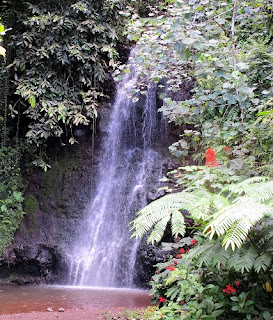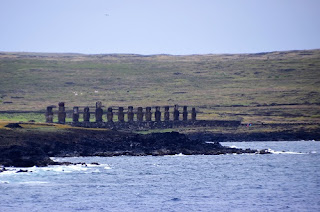
Our Cruise Director had been to Easter Island 5 times before
and was only able to get onto the island 2 times, 40% of the time.
Now it is down to 33 1/3%.
The forecast called for rain, but that did
not slow us down.
We just laid out
raincoat and umbrellas.
The waves were
not too big, and the wind was manageable.
However, the “ocean swell” was about 3 meters.
The opening of the tender landing is about 3
meters above water level.
This means
that any additional water height from a wave would wash sea water into the
ship.
Add to that the fact that there
could be 0 – 10 feet difference between the height of the tender port and the
door to the tender, and the captain decided that we would not be going ashore
“for the safety of the crew and the passengers.”
It is disappointing, but understandable.
The next best thing which he could do was to have the local
representative give a narration as we slowly circled the island. Any pictures we took were with maximum
magnification and the moai (statues) are still small and not too clear. If you want better pictures, I suggest you look on the Internet.

Easter Island was first discovered by Europeans on Easter Sunday, hence the name of the island. There have been other names suggested, such as St. Charles by the first missionaries and
Rapa Nui for the original inhabitants. This is another volcanic island first populated by Polynesians several centuries ago. Over the years all the trees were cut down to clear pasture and crop land. Now there is an effort to reforest the island, partially to combat erosion.
Easter Island is most famous for the large stone figures standing facing inland. In most places there is a single statue, but along the coast there are 2 places where several moai are lined up along the shore. Each statue represents an ancestor who was head of the family.
Some of the moai are located in the heart of the town but others seem to stand alone guarding open fields. The smallest is about 3 feet tall, and the largest is over 10 feet tall and weighs about 8 tons. All of them face away from the sea, so all we saw was the back side.
No one knows how the figures were transported to the final site since all were carved from volcanic rock at a single quarry near one end of the island. There is no definite time period when this was done, but the newest statures are the largest. By the time Europeans discovered the island, new statues were no longer being carved. In fact, there are a couple hundred incomplete carvings remaining in the volcano site.
 |
All the moai were carved from this
extinct volcano. |
After the moai were no longer carved, the inhabitants came up with a new way to select the ruler. Each village chose a strong young man to represent the village. These men were specially trained for the "bird man" quest. Once a year they would assemble at the top of a high cliff overlooking 3 small islands. They had to climb down the cliff, swim across the rough water to one of the islands and wait for the arrival of a particular type of bird. Next they had to snatch an egg from the nest, tie it to their forehead, swim back and climb the cliff, all without breaking the egg. The leader of the village represented by the first successful "bird man" then poked a hole in the egg and ate the contents. He became ruler of the island for 1 year, but it was not all glory. He was put in isolation for 6 months, talking only to the chief priest. Then he had 6 months to rule before the whole process was repeated. The last contest took place in the mid 1800s.
We may try to visit Easter Island again some day, but I think we will fly the next time!





 Everywhere we went there were statues.
Everywhere we went there were statues.












































